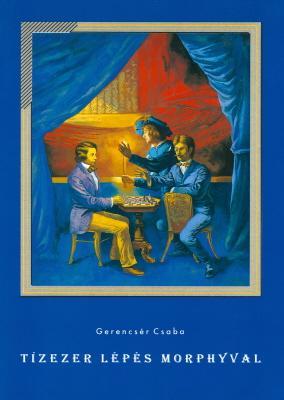
Edward Winter

The front cover of Tízezer Lépés Morphyval by Csaba Gerencsér (1995)
‘The most famous game of all time’ was the heading used by Frank Marshall on page 54 of Comparative Chess (Philadelphia, 1932) to describe Morphy against the Duke and Count, Paris, 1858 (1 e4 e5 2 Nf3 d6 3 d4 Bg4 4 dxe5 Bxf3 5 Qxf3 dxe5 6 Bc4 Nf6 7 Qb3 Qe7 8 Nc3 c6 9 Bg5 b5 10 Nxb5 cxb5 11 Bxb5+ Nbd7 12 O-O-O Rd8 13 Rxd7 Rxd7 14 Rd1 Qe6 15 Bxd7+ Nxd7 16 Qb8+ Nxb8 17 Rd8 mate).
A point on which sources vary is the opera that was being performed, i.e. whether it was The Barber of Seville or Norma. This question was raised in C.N. 120, and in C.N. 159 W.H. Cozens responded: ‘Who cares? When Michelangelo was painting the ceiling of the Sistine Chapel, who cares what chant was heard from below?’ Even so, it is a matter which has interested other chess writers (e.g. D.J. Morgan on page 362 of the November 1954 BCM and C.J.S. Purdy on page 276 of the December 1955 Chess World).
Given that H. Golombek participated in the Barber of Seville/Norma discussion (BCM, January 1955, page 33), it is curious to find on page 142 of his 1976 book A History of Chess no mention of Norma but, instead, the following:
‘This was in a consultation match against Count Isouard de Vauvenargue and the Duke of Brunswick, in a box at the Paris Opera during a performance of The Barber of Seville. There has been some dispute over whether it was this opera of Rossini’s or another, La Cenerentola, but at the moment of writing, the Barber has it.’
A fourth opera drawn into the affair, thus providing a kind of barbershop quartet, is The Marriage of Figaro. See, for instance, page 25 of The World’s Great Chess Games by R. Fine (New York, 1951), which asserted:
‘The story goes that it was played during The Marriage of Figaro, and that the Paris editorials next day criticized the Duke of Braunschweig for being so sacrilegious as to play chess at the opera. The Duke sued – and lost!’
Whether anybody can take this beyond Fine’s ‘The story goes’ stage remains to be seen.
The most detailed accounts of Morphy at the opera appeared on pages 172-173 of F.M. Edge’s book on Morphy and pages 158 and 160 of Paul Morphy The Pride and Sorrow of Chess by D. Lawson (New York, 1976). Below is the relevant passage from the latter:
‘The Duke of Brunswick, with whom Morphy first dined on 19 September, was a confirmed chessplayer, hardly to be seen otherwise than at chess. Edge says they were frequent visitors to the Duke’s box at the Italian Opera and even there the Duke played chess. On their first visit in October they played chess throughout the entire performance of Norma. Edge mentions Morphy’s discomfiture when he was the Duke’s guest, since he was obliged to sit with his back to the stage, while facing the Duke and Count Isouard consulting against him.
On 2 November they heard The Barber of Seville, during which Morphy played his most famous game, the Duke again consulting with Count Isouard.’
Disparaging remarks have sometimes been made about the allies’ chess ability, but the score below shows that the Duke of Brunswick could play a respectable game:
Duke of Brunswick – Prince of Villafranca and Valguarnera1 e4 e5 2 Nf3 Nc6 3 d4 exd4 4 Bc4 Bb4+ 5 c3 dxc3 6 O-O cxb2 7 Bxb2 Kf8 8 Nc3 d6 9 Nd5 Bc5 10 e5 Be6 11 exd6 Bxd6 12 Nd4 Qh4 13 Nxe6+ fxe6 14 Qf3+ Nf6 15 g3 Qxc4 16 Nxf6 Nd4 17 Bxd4 Qxd4 18 Ne4+ Ke7 19 Rad1 Qe5 20 Nxd6 cxd6 21 Qxb7+ Kf6 22 Rfe1 Qc5
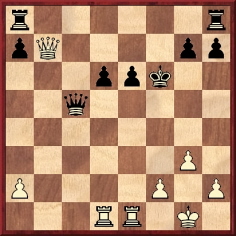
23 Rxe6+ (‘Very well played. From this move onwards White plays his game remarkably.’ – Rosenthal.) 23…Kxe6 24 Re1+ Kf5 25 Qf3+ Kg5 26 Re6 Qc1+ 27 Kg2 g6 28 Qf6+ Kh6 29 Qh4+ Kg7 30 Re7+ Kg8 31 Qf6 (Forcing a clear-cut mate, although 31 Qe4 Kf8 32 Rd7 is faster.) 31…Qc6+ 32 Kh3 Qc8+ 33 g4 Qf8 34 Qe6+ Resigns.
Source: La Stratégie, 15 April 1870, pages 93-94.
The Duke of Brunswick died in Geneva in 1873 and received a half-page obituary on page 274 of La Stratégie, 15 September 1873. A footnote on that page referred to the Morphy consultation game, where the other consultant was named as ‘le comte Isoard de Vauvenargue’. We have been unable to trace an obituary of the Count in the French magazine, whose rare mentions of him had ‘Isoard’, rather than ‘Isouard’. The correct spelling of the other part of his name also remains to be established beyond doubt (i.e. whether it concluded with an s). For example, pages 49-50 of La Stratégie, 15 March 1867 listed the Committee members for that year’s Paris tournament as including ‘le Comte Isoard de Vauvenargues’. [So did the Paris, 1867 tournament book (e.g. pages xiv and xx).]
On page 189 of his book In the Dark (Coraopolis, 1985) the ever-innovative G. Koltanowski referred to ‘the famous game Morphy played at the Opéra de Paris against the Duke of Brunswick and the Count de Mongrédien, in consultation’.
(2892)
On page 45 of Chess Review, February 1956, Fred Reinfeld wrote:
‘Like many another great composer, Rossini knew a good tune when he stole one. Perhaps that is why his masterpiece, The Barber of Seville, is so full of gay and witty melodies. Yet the day may come when this opera will be remembered only as the occasion of Morphy’s most brilliant game!’
This text also appeared on page 123 of Morphy Chess Masterpieces by Fred Reinfeld and Andrew Soltis, except that in that book (published in 1974, ten years after Reinfeld’s death) ‘Yet the day may come’ was replaced by ‘Perhaps the day will come’.
An odd suggestion in both wordings. At all events, some chess writers have claimed that the Morphy miniature was played during a performance of Bellini’s Norma.
(Chess Café, 1998)
Christian Sánchez (Rosario, Argentina) has consulted the fortnightly magazine L’Univers Musical of October and November 1858. He reports that although Morphy’s name did not appear, the 16 October and 1 November numbers mentioned that the October performances at the Théâtre-Italien included Norma, while the 15 November issue stated that The Barber of Seville had been performed that month. This schedule is in line with the information quoted from Lawson’s book above.
(2895)
Mr Sánchez added that the only chess figure he found mentioned in L’Univers Musical (1 November 1858) was Eugène Rousseau:
‘Mademoiselle Eugénie Saint-Marc, artiste du théâtre du Vaudeville, vient d'épouser M. Eugène Rousseau, secrétaire-général du théâtre des Varietés.’
As noted on pages 198-199 of Kings, Commoners and Knaves, Edward Lasker stated that he had played the same game as Morphy. After annotating Morphy v the Duke and Count he wrote:
‘The logical sequence of the moves in this game, as pointed out in the commentaries to it, is borne out by the curious coincidence that I once had the opportunity of playing a game in exactly the same sequence of moves, against a player to whom Morphy’s “brilliancy” was unknown.’
Source: Chess Strategy by Edward Lasker (London, 1915), page 26.
The following offhand game features a neat trap at move 21 and a finish which is a mirror image of the Morphy game:
Albert Beauregard Hodges – Daniels
Nashville, December, 1886
Vienna Gambit
1 e4 e5 2 Nc3 Nf6 3 f4 Nc6 4 fxe5 Nxe5 5 d4 Ng6 6 e5 Ng8 7 Bc4 Nxe5 8 Bb3 Ng6 9 Nf3 Nf6 10 O-O d6 11 Ng5 d5 12 Qe2+ Be7 13 Rxf6 gxf6 14 Nxd5 fxg5 15 Bxg5 Be6 16 Nxe7 Nxe7 17 d5 f6 18 Bxf6 Rf8 19 Qxe6 Qd6 20 Ba4+ Kd8
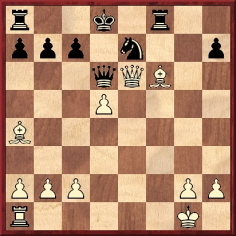
21 Re1 Rxf6 22 Qg8+ Nxg8 23 Re8 mate.
Source: Brooklyn Chess Chronicle, 15 April 1887, page 109.
(2088)
Next, a game in which the Duke and Count are on opposite sides of the board:
Count Iso[u]ard and Viscount Casabianca – Duke of Brunswick
and Daniel Harrwitz
Paris, June 1857
Sicilian Defence
1 e4 c5 2 Nf3 Nc6 3 Bc4 e6 4 Nc3 a6 5 a4 g6 6 d4 cxd4 7 Nxd4 Bg7 8 Nde2 Nge7 9 O-O f5 10 exf5 Nxf5 11 Bd3 O-O 12 Bxf5 Rxf5 13 Ng3 Rf7 14 Nce4 d5 15 Nc5 Qe7 16 Nd3 e5 17 Re1 Be6 18 f3 Raf8 19 c3 h5 20 Be3 d4 21 cxd4 exd4 22 Bf2 h4 23 Ne2 h3 24 Bg3 Bh6 25 f4 hxg2 26 Nf2 Bg7 27 Ne4 Bd5 28 Ng5 Rf5 29 Rc1 Qd8 30 Rc5

30…d3 31 Qxd3 Qxg5 32 Rd1 Nb4 33 Qd2 Qg4 34 Re1 Re8 35 Qxb4 Rxe2 36 Rxd5 Rxd5 37 Qc4 Bd4+ 38 Bf2 Bxf2 mate.
Source: Chess Monthly, January 1858, pages 19-20.
(2388)
C.N. 4931 gave a chart, from page 130 of the May 1935 Deutsche Schachzeitung, depicting the Morphy game in terms of the units’ mobility after each move.

Finally, as noted on page 148 of A Chess Omnibus there is no consensus among today’s masters about the Morphy game. In C.N. 2287 Yasser Seirawan informed us:
‘Regarding the best game of chess ever played, certainly none of my own games spring to mind. Morphy v the Duke and Count is arguably the most quoted game of all time and has much that is special about it. It is fair to say that no other game has brought so much pleasure to so many. The best game of chess ever played? Can there be such a thing? Would a perfect game not be boring? Can a mere off-hand game be the best ever? I don’t know the answers and, in spite of the questions, Morphy v the Duke and Count gets my vote.’
A contrasting view was expressed by John Nunn on pages 4-5 of his book Learn Chess (London, 2000):
‘One of my pet hates is the choice of games for beginners’ books. There are certain standard examples that tend to be repeated in book after book. In many beginners’ books, you will find the game Morphy vs Count Isouard and the Duke of Brunswick, played during a performance of the Paris Opera in 1858. It’s not an especially good game, as one might expect when the strongest player of his day confronts two duffers. Moreover, it has always seemed to me faintly incredible that authors couldn’t find a relevant example less than 140 years old. In this book, every game and game extract is from the twentieth century (indeed, only two are earlier than 1950). The style of chess played today is quite different from that of 1858, and while some of the differences are subtle, there is no reason why players should not be exposed to contemporary chess thought from the beginning.’
(Chess Café, 2001)
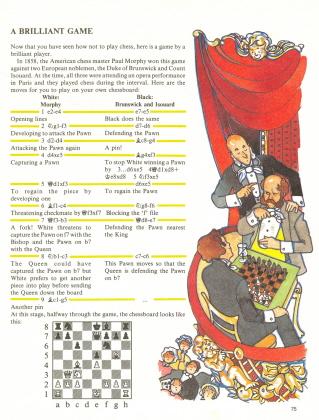
Page 75 of Purnell’s Chess for Children by Martin J. Richardson (Bristol, 1984).
Fabrizio Zavatarelli (Milan, Italy) notes that the information
quoted above from David Lawson’s book (‘On 2 November they heard The
Barber of Seville, during which Morphy played his most
famous game, the Duke again consulting with Count Isouard.’) does
not match the announcements of opera performances published in the
Parisian newspaper La Presse.
Page 3 of the (Sunday) 31 October 1858 edition announced two operas being performed on 1 November:
Page 3 of the 1-2 November 1858 issue of La Presse stated that the following would be performed on 3 November:
Page 3 of La Presse, 3 November 1858 announced these performances on 4 November:
The Opéra was not listed as a venue in the 3 November newspaper.
Does a solid contemporary source exist to support the date of the
Morphy game put forward by Lawson? The listings in La Presse
suggest that there were no theatrical performances at all on 2
November, a day of prayer in the Roman Catholic Church (Le jour
des Morts/All Souls’ Day).
(6582)
Regarding the correct spelling of the Count’s name, Kevin O’Connell (Mouret, France) informs us:
‘1. Vauvenargues (Vauvenarga or Vauvenargo in the Provençal language, which was still dominant in the area in the 1870s) is a village in Provence. Vauvenargues is the French version, but the village is located in Occitania and so has its Occitan name, but there are six dialects, of which Provençal is one. Within Provençal there are two orthographical norms, one of which gives “Vauvenargo” and the other “Vauvenarga”. The latter would almost certainly be favoured today.
2. The château, bought by Picasso in 1958, belonged to the Isoard family from 1790 to 1943. Information is available under “Histoire et patrimoine” at the website of the Mairie de Vauvenargues.
3. In all variants of Occitan (including Provençal) “o” is invariably pronounced “ou” unless it has a grave accent (ò), in which case it should be pronounced like the “o” in Opéra.
4. In spelling the Count’s name today, there is certainly some latitude, but I suppose that it should officially be Comte Isoard de Vauvenargues, in recognition of the considerable success of the French authorities (during the approximate period 1870-1930) in almost stamping out the language of the people of the southern half of France, even though it is 99% certain that his name was pronounced “Isouard”.’
(6740)
From page 103 of Šachový slabikář by I. Veselá and J. Veselý (Prague, 1991):
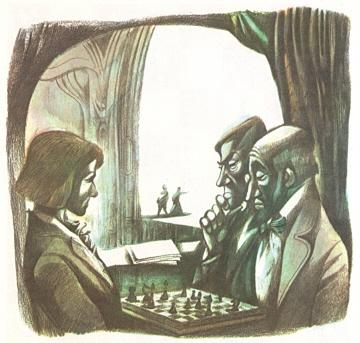
Unusual misspellings include ‘Isnouards’, which occurs twice on page 66 of Les échecs par la joie by Aristide Gromer (Brussels, 1939).
On page 7 of the December 2013 CHESS Nigel Short mentioned the Morphy game as his favourite of all time (‘First loves are always the deepest’).
Hans Renette (Bierbeek, Belgium) provides a cutting from page 4 of the Innsbrucker Nachrichten, 26 November 1857 (i.e. about a year before the Morphy v the Duke and Count game):

‘Paris, 13 Nov. Yesterday, Duke Charles of Brunswick caused a great scandal at the Théâtre des Italiens. He was playing chess with his companions during the performance and making so much noise that the theatre’s director had to demand that he be quiet.’
(8600)
In the first volume of Napier’s Amenities and Background of Chess-Play (Brooklyn, 1934) it was game 68 and was described as ‘The most celebrated game’.
A few jottings on a colourful old phrase.
From page 181 of How To Get More Out Of Chess by F. Reinfeld (New York, 1957):
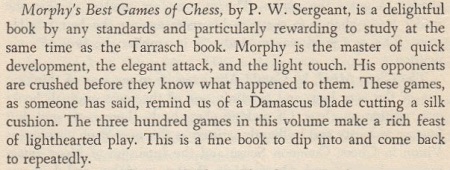
(There was no ‘Best’ in the title of Sergeant’s book, as Reinfeld should have known, given that, also in 1957, he contributed an Introduction to a new Dover edition.)
The ‘someone’ who made the Damascus blade remark was Sergeant himself, at the end of Game LXXIX (Morphy v the Duke and Count) in Morphy’s Games of Chess (pages 149-150):
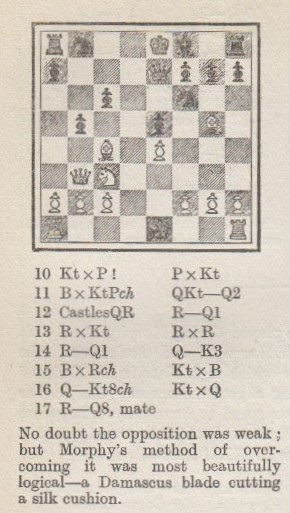
That Reinfeld was aware of this is shown by the conclusion of his article about the game on page 45 of the February 1956 Chess Review:
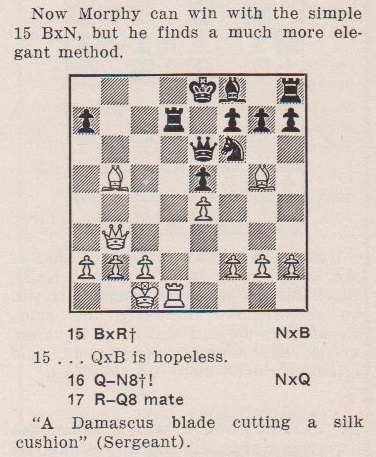
(9448)
Page 68 of the May 1907 issue of the Chess Player’s Scrap Book gave the bare score of Morphy v the Duke and Count with the following introduction by Lasker:
‘This is a great game, played against a weak combination. On the eighth move White could have won the QKt pawn, which would have been good enough to win the game, or played BxPch, followed by QxKtP. But that would have been a butcher’s method, not an artist’s.’
Lasker’s butcher/artist remark has often been quoted sourcelessly (e.g. in P.W. Sergeant’s first monograph on Morphy) with reference to 8 Bxf7+, and not also 8 Qxb7.
(10503)
Eduardo Bauzá Mercére (New York, NY, USA) notes that pages 225-226 of Paul Morphy, Sketch from the Chess World by Max Lange (London, 1860) give the celebrated consultation game as played at the Italian Opera during a performance of The Barber of Seville, which, in accordance with the information provided by Fabrizio Zavatarelli in C.N. 6582, suggests 4 November 1858.
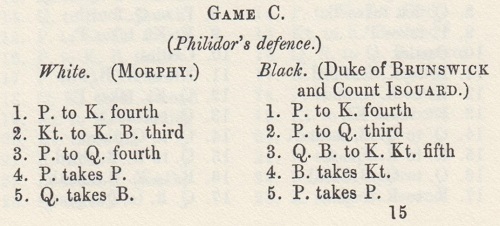
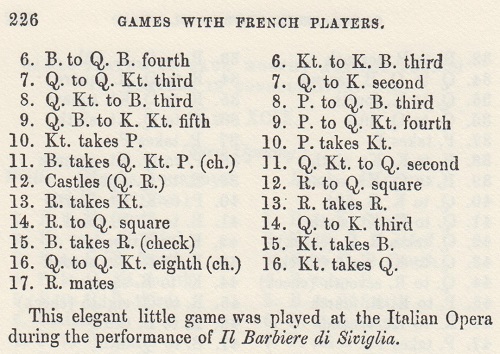
However, we add page 210 of a later German edition of Max Lange’s monograph, Paul Morphy Sein Leben und Schaffen (Leipzig, 1894), where the heading had a date (October 1858):
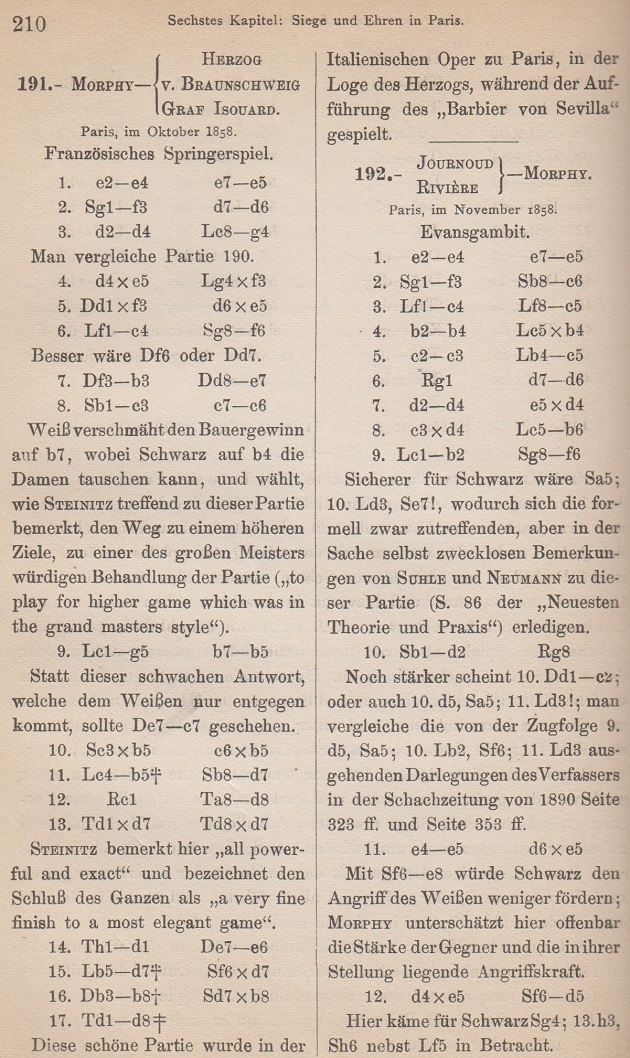
On the basis of the 1858 documentation about Paris opera performances which has been found so far, the statements ‘October 1858’ and ‘The Barber of Seville’ cannot both be correct.
(11537)
From Fabrizio Zavatarelli:
‘Morphy first dined with the Duke of Brunswick on 19 September 1858 (Lawson, page 158), which is a post quem date. C.N. 6582 reported my findings in the Parisian publication La presse, which announced daily the performances in Paris theatres. My search covered 19 September-31 December 1858.
As shown in C.N. 11537, Max Lange specified that the famous consultation game was played during a performance of Rossini’s The Barber of Seville at the Italiens. There are no possible dates in October, and the only ones in November are 4, 13 and 14; the last of those is unlikely, given the Deutsche Schachzeitung report mentioned below. There was a performance of The Barber of Seville on 23 December, but that has to be ruled out for the additional reason that Morphy was ill (during his match with Anderssen).
According to a report on pages 492-493 of the December 1858 Deutsche Schachzeitung, Morphy had played in consultation against the Duke and the Count more recently than against Chamouillet and Laroche. Although there are no extant consultation games involving Laroche, page 2 of the Supplement to Bell’s Life in London, 31 October 1858 published a “game just played by Paul Morphy (blindfold) against M. Chamouillet and the rest of the members of the Versailles Chess Club, all in consultation”.
On page 172 of his book on Morphy, F.M. Edge wrote regarding the Duke of Brunswick that “we were frequent visitors to his box at the Italian Opera”, and that on the first occasion the opera was Norma. The relevant possible dates are 21, 23, 26 and 30 October. Norma was also performed on 9 and 28 December, but those dates seem too late in view of the above-mentioned report in the Deutsche Schachzeitung.
To summarize, it appears that Morphy v the Duke and Count was played either during a performance of Norma on 21, 23, 26 or 30 October 1858 or, most probably, during The Barber of Seville on 4 November 1858.’
(11541)
As shown at the English Chess Forum, Geoff Chandler has written falsehoods about our treatment of the Morphy opera game, also demonstrating his reluctance/incapacity to set matters straight. We have never said which opera was being performed, because we cannot say. All available evidence has been quoted impartially, whichever way it leans.
See too Paul Morphy and The Best Chess Games.
To the Chess Notes main page.
To the Archives for other feature articles.
Copyright: Edward Winter. All rights reserved.